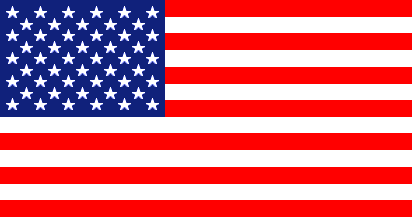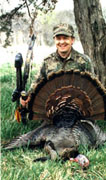|
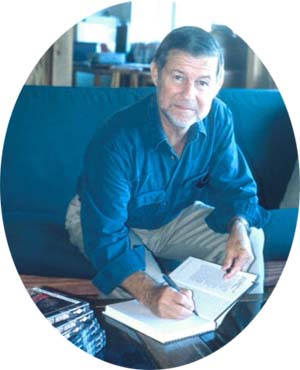 Preface Preface
This book has a
resemblance to my Art & Science of Wild Turkey Hunting
published in 1989 because I have retained from it some of the photos and a
few of my favorite turkey hunting anecdotes, but more has been added than
retained and the retained parts have been completely re-written and
up-dated.
Added material
includes parts of two of my out-of-print books—
The Voice and Vocabulary of the Wild Turkey
and Managing wild turkeys in Florida. I have added topics
from After the Hunt with
Lovett Williams including a chapter on how to make and use a
wingbone yelper, and a new chapter on the Gould’s wild turkey based on
my work in the Sierra Madre Occidental of Mexico since 1989. There is also
an account of the origin of the Merriam’s wild turkey which I was not
aware of when The Art & Science was written. There are also
different color illustrations and updated and corrected maps of the wild
turkey’s distribution. The compact disk inside the back cover, which is
new, presents narrated audio recordings of the calls used in turkey
hunting and in calling contests as discussed in the text.
The term management
in the title reflects an increased emphasis in the present edition on
managing wild turkeys on private land. The advice I offer is based on what
I have learned in 50 years of observing, studying, and managing wild
turkeys and other wildlife. The focus is on practices to maximize wild
turkey numbers but I know that many managers do not wish to go to that
extreme. Managers must decide for themselves how much effort and budget
can be assigned to wild turkeys and most will prefer to “optimize”
turkey numbers rather than “maximize” them.
Some practices
used in managing wild turkey populations are helpful to other wildlife but
some are not. No land management practice fits all wild species. To insure
balance, land managers would benefit from the assistance of a trained and
experienced wildlife consultant in drawing up a management plan. The free
advice that so abounds in popular publications about wildlife management
is worth exactly what it costs.
My management
recommendations are heavily flavored with ecological principles. I do not
go deeply into agricultural and animal husbandry approaches because they
are untested substitutes for the turkey’s real needs. The wild turkey is
well suited for life in the natural environment of North America where it
evolved. Planted food crops can only supplement what Nature has always
provided. It took natural processes millions of years to bring the turkey
to where it is today and the best we can do to enhance its well being is
to work effectively with Nature. I will attempt to explain how to do that.
Another theme
is about how to become a more successful turkey hunter. My goal is to
encourage better hunting skills because skill leads to greater hunting
success and to greater appreciation of the wild turkey and the great
outdoors. Appreciation of wildlife and nature is the fuel of conservation.
My studies of
the wild turkey have been mostly in my native state of Florida where
eastern and Florida turkey populations meet. Museum taxonomists named
certain wild turkey populations as “subspecies” during an era when
zoologists believed that subspecies were “mini” species in line to
evolve over time into bona fide species of their own. Zoologists
have since abandoned the naming of new subspecies because of its false
implications. The forum on subspecies of birds published in the journal of
the American Ornithologists’ Union (see Weins, 1982 in Literature Cited)
explains the present lack of scientific interest in subspecies
designations and should be mandatory reading for all professional wildlife
people. Continued use of subspecies names in professional writing only
sustains out-dated concepts.
Although
today’s ornithologists have little interest in subspecies, I use five
subspecific names in referencing geographic populations because the names
are useful labels in describing the slams of wild turkey hunting and, in
that regard we are, after all, dealing with sport, not science.
Literature
citations and footnotes are used in scholarly books so that readers can
evaluate the validity of ideas presented and to credit other researchers
and writers. I have cited sources but only sparingly because citations are
distracting to the reader and I don’t think important in a book of this
type. I hope no biologist or writer is offended.
I make
frequent use of the adverbs usually, almost, normally, mostly, rarely,
frequently, and modifying phrases like most likely because I
do not know enough about turkeys to use terms such as never and always.
Besides, I am not sure there is anything that turkeys always or never do.
I have limited
the book to what I know. The literature discussed in the Chapter 11 and
listed in Literature Cited can put the reader on the trail to all that has
been written about the wild turkey. But I would caution that not all that
has been written is true. A book bigger than all those combined would be
needed to describe what is not known. When you read, do so with caution,
consider the source, and realize that truth has to be discovered--it
cannot be created.
As more is
learned about the wild turkey, some of my interpretations will be improved
upon and some rejected. That’s the way we make progress. Meanwhile, if
you find errors in Wild turkey hunting and management, please
forgive me and if I am still around and you can find me, bring them to my
attention so I won't make the same mistakes again.
I have had a
lot of help with my wild turkey studies over the years as you will see
from a glance at the Acknowledgements, but any errors you find I made all
by myself.
Lovett E. Williams, Jr.
Cedar Key, Florida
Dust Jacket
|
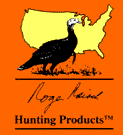

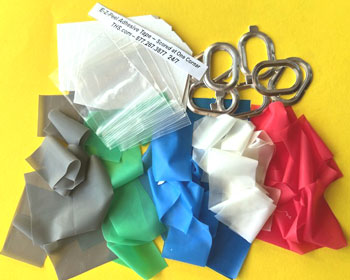


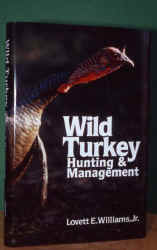 PLUS
PLUS 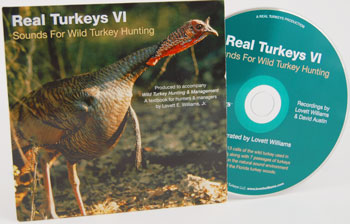
 Preface
Preface